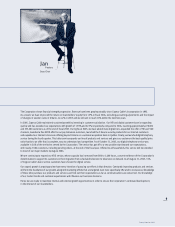Cogeco 2005 Annual Report Download - page 21
Download and view the complete annual report
Please find page 21 of the 2005 Cogeco annual report below. You can navigate through the pages in the report by either clicking on the pages listed below, or by using the keyword search tool below to find specific information within the annual report.
Cogeco Cable Inc. 2005
19
Management’s Discussion and Analysis
On the other hand, cable telecommunications also continue
to benefit from major technological progress, particularly
in the areas of modulation, digital compression, fractioning
of optoelectronic links, multiplexing, HD distribution and switched
video distribution. These developments lead us to believe that
wired distribution over fiber and coaxial cable will be an efficient,
reliable, economical and competitive distribution method
for existing and future broadband telecommunications services,
for the foreseeable future. However, this prospect depends on
the Corporation’s ability to make additional investments in
a timely fashion in order to deploy the necessary technical
improvements in its networks.
Growth in the penetration of HSI access of all types and the
emergence of new, more sophisticated algorithms for audiovisual
content, such as MPEG-4, will promote the increased distribution
and consumption of movies and television programs on demand
through an Internet connection. This trend opens up the possibility
that the market for existing analog and digital audiovisual
programming distribution services may become fragmented,
especially for movies, special events and specialized or repertory
programs. In the event of a significant migration of the audiovisual
content offering to an IP platform, it may happen that the revenue
and margins derived from HSI access services will not entirely
outweigh the loss of revenue or reduction of margins derived from
analog and digital video services.
Risks Pertaining to Regulation
Each of the Corporation’s activities is subject to a more or less
extensive regulatory framework, depending on the type of service
involved. The risks result from the very nature of the rules that are
in force, from their application, from their asymmetry depending
on the distribution technology used or from their future development,
as the case may be. Canadian legislation governing broadcasting,
radiocommunications, telecommunications, copyright and the
protection of personal information are the main sources of relevant
regulations. New federal regulatory policies currently under
consideration in the areas of telecommunications, copyright, lawful
access to customers’ personal information and control over spam
may all have a substantial impact on the Corporation’s activities
and on the operating costs it will have to incur to comply with them.
Provincial consumer protection laws also have a major impact on
the way these activities are carried out. During the last fiscal year,
the Corporation was obliged to devote resources to review its sales
and customer account management processes in order to comply
with the increased requirements of regulations under the new
Ontario law. Management believes that it has implemented the
information and verification measures required by the regulations,
but the new law nevertheless makes it easier for consumers
to take legal action, either individually or collectively.
The regulations governing the cable distribution of video or audio
services, particularly in analog mode but also in digital mode,
are still very detailed and restrictive. Indeed, the current framework
imposes numerous structural constraints on Canada’s major
cable companies, particularly regarding the use of the networks’
distribution capacity, the choice of services that may be distributed,
the distribution mode for each type of programming service,
the wholesale price and other conditions of distribution contracts,
the composition of basic service, the bundling of programming
services, access to the sale of advertising or sponsorship messages,
cross-promotion of the cable company’s other services and financial
contributions to support Canadian programming. The Canadian
Cable Telecommunications Association, of which the Corporation
is a member, is pursuing its efforts to obtain greater flexibility
and to eliminate regulatory asymmetries, for the greater benefit
of customers, but no significant changes will occur in the short term.
HSI access services are not regulated. Even though the Internet
access market is already extremely dynamic and competitive,
the Corporation is nevertheless obliged to provide access to its
networks to third-party Internet service providers who request it,
according to terms established in an access tariff approved by
the Canadian Radio-television and Telecommunications Commission
(CRTC). This means that the Corporation must accommodate several
competitors on its networks in Ontario and Québec.
As far as telephone services are concerned, the Corporation decided
to launch a new digital telephony service in the last fiscal year.
The CRTC has ruled that there are grounds for applying the same
regulatory framework to the incumbent telephone companies’ VoIP
services until competition develops in the market. This ruling is being
challenged on two fronts: in the federal cabinet and in the Federal
Court of Appeal. Incidentally, the CRTC has initiated a proceeding
to consider whether it should forbear from regulating telephone
services that are still subject to regulatory control. The CRTC’s
decision on the criteria, conditions and timetable for forbearance
on these services will not become known until later in the 2006
fiscal year.
Risks Pertaining to Operating Costs
The Corporation is continuing its efforts to mitigate the impact
of costs of goods sold on Operating Margin growth. It is obliged
to deal with increases in input costs which cannot always be entirely
anticipated or controlled, either because of regulatory decisions
or because of the power of certain suppliers of products or services.
On this point, the outcome of negotiations concerning the wholesale
fees payable to the main specialty or pay television channels whose
contracts have expired or are due to expire, or for the fees payable
to the major studios for movies for VOD service, is often fraught
with uncertainty.
A new long-term agreement with Hydro One for the use of support
structures should be reached shortly. Cogeco Cable is also currently
negotiating with Hydro-Québec, its primary supplier of support
structures in Québec.
























